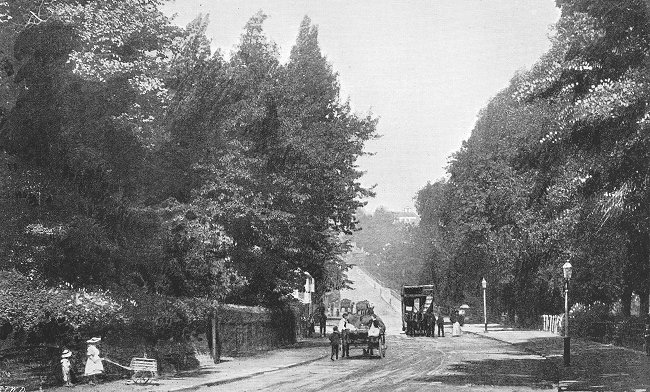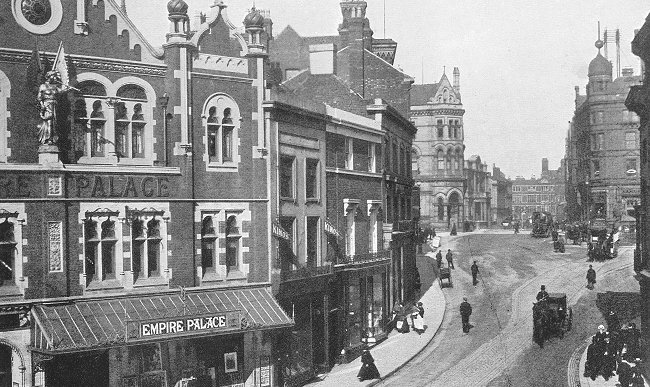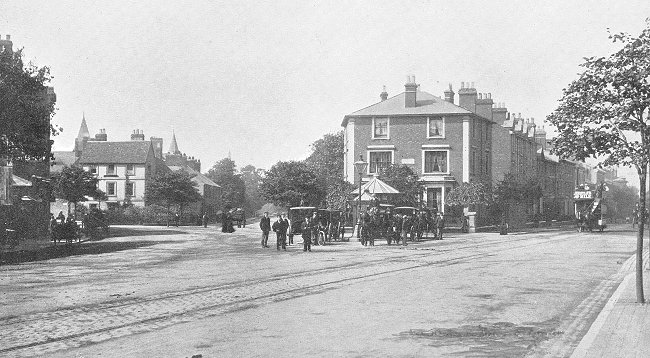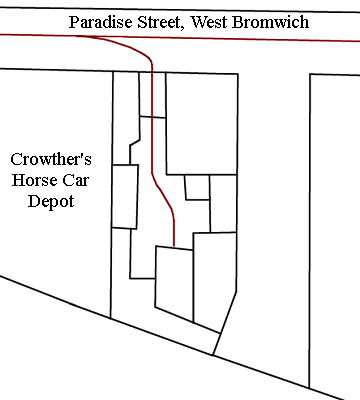|
The Black Country’s first
passenger-carrying tramways
In the 1860s a number of private
companies wanted to construct tramways to allow them to
operate horse-drawn trams along the roads of our towns and
cities. Local authorities were greatly opposed to this,
because it was their responsibility for the upkeep of the
roads, and so it would be unacceptable to allow private
companies to dig-up their roads in order to lay tramlines.
A number of local authorities,
including Birmingham, appealed to the government for
legislation to control the construction and working of
tramways, which resulted in the passing of the 1870 Tramways
Act. This authorised local authorities to construct tramways
in response to orders from the Board of Trade, and then
lease them to private operators. At that time, local
authorities were not allowed to run passenger-carrying
tramways themselves.
On the day following the passing of the
Act, a second tramways act covering Birmingham and
Staffordshire was passed. It had been promoted by the
Birmingham & Staffordshire Tramways Company to lay tramways
outside the Borough of Birmingham. The Birmingham &
Staffordshire Tramways Act, 1870 authorised the construction
of a 4ft. 8½ inch gauge horse-drawn tramway from the
Birmingham-Handsworth boundary at Hockley Brook, through
Handsworth and West Bromwich to Carter’s Green, where the
line forked into two branches. The first went to Great
Bridge and Dudley Port, ending near the London & North
Western railway station. The other branch went to Hill Top,
ending by the Hen and Chickens pub, near the top of Holloway
Bank. They were the earliest passenger-carrying tramways in
the Black Country, which were operated by the Birmingham and
District Tramways Company, formed on 29th July, 1871 to
construct and operate the network. The new company was an
amalgamation of the Birmingham & Staffordshire Tramways
Company and the Birmingham Tramways Company.
The tramway opened on Monday 20th May,
1872, and long queues formed as people waited for a ride on
the double-deck horse cars, which provided an hourly
service. Twelve cars numbered one to twelve were built for
the tramway by the Metropolitan Carriage and Wagon Company
Limited, of Saltley. They carried 18 people seated inside and
18 out, and were painted in crimson and cream. By June,
eleven of them had been delivered and were in service. The
trams were so popular that from the 4th July the service was
increased from hourly to half hourly, and horse-drawn
omnibuses were running from Birmingham to link with the tramway
at Hockley Brook. By August the company was running
alternate cars on the route, from Hockley to Hill Top, and
Hockley to Dudley Port.
The company promoted another Bill which
was authorised by Parliament in 1872. This was the
Birmingham and Staffordshire Extension Tramways Act which
permitted the construction of an extensive system of lines
in the Black Country, but most were never built.
Birmingham Corporation began building
its first tramway in May 1873 under the terms of the
Birmingham (Corporation) Tramways Order of 1872. The line
ran from Colmore Row (then Monmouth Street) to Hockley
Brook. It cost £15,000 to build and was completed in August
1873. The company agreed to lease the line for seven years
at an annual rent of £910. Services began on 11th September,
but all was not well. There were problems with the original
track, which had been poorly constructed, leading to
disputes with Handsworth Highways Board. The track quickly
deteriorated, leading to safety concerns. Many horses were
lost after an epidemic at the stables, and the trams were
losing money. Many of the company’s omnibuses and some of
the trams were sold. The omnibus routes were abandoned, but
later operated by other companies.
The Carter’s Green to Dudley Port
branch closed at the end of December, 1873 and the track was
soon taken-up. The Carter’s Green to Hill Top section closed
in January 1875, and by May of that year the weekday service
only ran to West Bromwich Market Hall, and to Carter’s Green
on Sundays.
Losses continued, and a new company,
the Birmingham Tramways and Omnibus Company Limited
purchased the assets of the failing business on 1st May,
1876.
The company began to operate trams and
omnibuses in Birmingham. The line to West Bromwich closed at
the end of June, but a quarter of a mile of track running to
Sandwell Road was soon put back into use.
So ended the first tramways to operate
in the Black Country, but more would soon follow.
The Black Country’s second tramway
system
The second tramway system to operate in
the Black Country was centred on Wolverhampton. The
Wolverhampton Tramways Company Limited was formed on 14th
December, 1876 to construct horse tramways from
Wolverhampton, to Bilston, Newbridge, and Willenhall. Powers
were sought for the construction of the new tramways by the
Wolverhampton Tramways Order, 1877 that had been promoted by
the company. Construction was granted under the terms of the
Tramways Confirmation Act, 1877, passed on 23rd July, 1877.
|

A horse-drawn tram at the
Newbridge terminus. From 'A Souvenir of Wolverhampton'
published by Alfred Barker around 1900. |
|
The following tramways were authorised by the Act:
1. A line from the junction of Newbridge Crescent and Tettenhall Road to a terminus in
Queen Square by the statue of Prince Albert.
2. A line from the junction of Market
Place and Bilston Street, Willenhall to Queen Street,
Wolverhampton via New Road, Willenhall Road, and Horseley
Fields.
3. A line from the junction of
Lichfield Street and Church Street, Bilston to Queen Street,
Wolverhampton via Bilston Road, Bilston Street, and Piper’s
Row.
4. A line from the top of Horseley
Fields, into and along Railway Street as far as New Street.
All lines would be single track with
passing places, except for short sections in Bilston Street
and Piper’s Row, also in Queen Square, and Dudley
Street. The section in Dudley Street was not to be used for
traffic without seeking permission from the Corporation.
The Act also stated that should the
Corporation consent to a tramway from Railway Street to
Queen Square along Lichfield Street, which was yet to be
extended, the company should lay the track and remove the
lines in Queen Street and Dudley Street.
The Act gave Wolverhampton Corporation
the right to compulsorily purchase the tramways at any time
within ten years of the opening, and any time after twenty
one years.
The tramways could be used for the
conveyance of passengers, and also animals, goods, parcels,
and minerals, at the discretion of the company. Passenger’s
luggage should not exceed 28lbs. The trams were to be
horse-drawn on a 4ft. 8½ inch gauge track. The company was
asked to apply for a Provisional Order at the next session
of Parliament to authorise an extension of the tramway from
Bilston to Moxley, and that an omnibus service should be
operated between Bilston and Bradley until the company
applied for an order to build a tramway there. As far as is
known, the service never ran.
The company’s head office was at 23
Queen Victoria Street, London, and the directors were Sir
Wilfred Brett, T. M. Mackay, J. M. Gillies, C. E. Davison,
A. J. Lambert, and T. Selby, the company secretary.
The first route to be completed was the
one from Queen Square to Newbridge, just short of the
Wolverhampton-Tettenhall boundary, before the steep climb up
The Rock. The terminus had to be around fifty yards from the
toll gate at Newbridge to avoid paying tolls. The Board of
Trade carried out an inspection on 30th April, 1878 and the
line opened for business on 1st May. The full fare to
Newbridge was 2d.
|

A horse-drawn tram leaving the Queen
Square terminus in 1897. Courtesy of David Clare. |
Other lines soon followed. The
Willenhall route along Horseley Fields and the Willenhall
Road through Portobello was completed in May 1878 and opened
on 6th June. The Bilston route via Piper’s Row, Bilston
Street, and Bilston Road was completed early in July. A
trial run was carried out on 3rd July, 1878, and the line
opened in the middle of the month.
The first cars put into service were
single deckers pulled by one horse, although a ‘chain horse’
was needed to assist the climb up Darlington Street to
the terminus. The cars were 18 seaters built by John
Stephenson & Company of New York, and 22 seaters built by
Henry Hughes & Company of Loughborough.
Soon some double decker cars were
purchased from Henry Hughes & Company which were pulled by
two horses and seated 22 people on each deck. The cars were
mainly used on the busier Willenhall and Bilston routes.
|
|
The company’s premises in Darlington
Street consisted of the manager’s house and offices facing
the street, with an archway leading to the car shed and
stables. The manager was Captain Brock who was succeeded in
the 1880s by Mr. W. Stimpson. The company had around 45
staff. A second depot was soon built on Tettenhall Road,
about a quarter of a mile from the Newbridge terminus. It
was entered by a single track up a long driveway, and
consisted of a house, a double track car shed, two single
track car sheds, and stables. One of the single track car
sheds was possibly used as a repair shop because it
contained a full length pit.
In 1878 the company obtained permission
to build an extension of the line from Bilston to Moxley
under the terms of the Wolverhampton Tramways (Extension)
Order, and the Tramways Orders Confirmation (No.1) Act,
1878. The line ran from Church Street, along Oxford Street,
Bilston
to the junction of Moxley High Street and Holyhead Road.
Construction took place in 1879, and the line opened soon
after the Board of Trade inspection on 19th August, 1879. A
small depot was built on the south side of the road near the
terminus, and the line was operated by a single car working
a shuttle service to and from Bilston. It was based at the
Moxley depot.

Although the lines were operated by
horse-drawn trams, a successful trial using a steam tram
took place in 1881 on the Newbridge route. Details will be
found in the next section.
A Board of Trade return for 1882
includes details of the horses and cars. At the time there
were 110 horses and 20 cars. Over the intervening years the
number of horses fluctuated between 81 and 100. In 1892 a
further four double-deck cars were obtained from the Falcon
Engine & Car Works, successors to Henry Hughes & Company.
They probably replaced four of the original cars which were
scrapped. They operated on the Newbridge service and had six
windows on each side, and ‘garden’ reversible seats on the
upper deck.
In 1894 another car was scrapped, and
replaced the following year with a six-window double decker
built by George F. Milnes & Company. It was solely used on
the Newbridge service.
In 1884 the frequency of operation was
as follows:
| Newbridge |
Every 15 minutes with 4 cars. |
| Bilston |
Every 15 or 20 minutes with 4
cars. |
| Willenhall |
Every 30 minutes with 3
cars. |
| Moxley |
Every 40 minutes with one car. |
One old car stored at Newbridge had
been converted to an open truck which was used to convey materials for
track work, and to distribute salt and grit in the winter
months.
|

A view of Queen Square with a
horse-drawn tram at the terminus on the right. From 'A
Souvenir of Wolverhampton' published by Alfred Barker
around 1900. |
|
The British Electric Traction Company
(B.E.T.) approached the company with a proposal to purchase
the tramways, but without success. By 1898 B.E.T. had
obtained a controlling interest in the company, and
Wolverhampton Corporation had decided to promote a
Parliamentary Bill to build and operate the local tramways
itself.
At the annual meeting of the
Wolverhampton Tramways Company Limited on the 14th February,
1899, the accounts showed a profit of £5,886, the takings
being £13,486, a total of £188 up on the previous year. The
total car mileage for the year was 220,053, and 1,791,273
passengers were carried. Mr. Emile Garcke of B.E.T. who took the chair
at the meeting stated that Wolverhampton Corporation had
given notice under section 43 of the Tramways Act, 1870 to
purchase all the tramways within the Borough, and that B.E.T.
had come to a provisional agreement with the company to
purchase the sections of the tramways outside the Borough,
providing that the terms would be similar to those obtained
from the Corporation. This was subject to the company being
able to obtain Parliamentary powers to alter the gauge to
3ft. 6 inches and for the use of electric traction on the
lines.
The company successfully promoted a
Bill to obtain the necessary powers, which became law in the
form of the Wolverhampton Tramways Act, 1899. In the same
year the Corporation’s Bill was passed as the Wolverhampton
Corporation Act, 1899. It gave the Corporation the power to
reconstruct and electrify the existing tramways within the
Borough, and to construct additional tramways within and
outside the Borough, all to the 3ft. 6 inches gauge, and to
operate them. It also included a clause precluding the
Corporation from constructing lines in opposition to B.E.T.
outside the Borough. It also granted powers to purchase or
lease tramways outside the Borough which formed part of the
existing tramways, subject to the consent of the local
authority, and of B.E.T. for the lines in Bilston, Coseley,
Darlaston, Sedgley, and Willenhall.
After the passing of the Wolverhampton
Tramways Act, 1899 the company and the Corporation could not
reach agreement on the price to be paid for the tramways.
After much discussion and correspondence, the Corporation
applied to the Board of Trade for an arbitrator to settle
the matter. The Board appointed Sir Frederick Bramwell who
oversaw the arbitration meeting at Wolverhampton Town Hall
on 20th February, 1900. Everything had been examined by
experts acting for both sides. The track was in a bad
condition, since little maintenance work had been carried
out since the formation of the company. After much
deliberation, the arbitrator decided that the tramways were
worth £22,500, made-up as follows:
Track - £11,000; Depots - £7,500;
75 Horses - £1,800;
11 cars, harnesses etc. - £1,200;
Parliamentary costs - £1,000. |
Most of the company’s 45 employees were
taken-on by the Corporation, as was the manager, Mr.
Stimpson. He was retained by the Corporation as manager of
the horse tramways, pending electrification, which happened
in 1902. The purchase date was 1st May, 1900, but that
wasn’t the end of it. The company failed to reach an
agreement with B.E.T. over the sale of the tramways outside
the Borough. Around October, 1900 the matter was again
settled by arbitration. At the last annual meeting of the
Wolverhampton Tramways Company Limited, on 11th March, 1901,
the company was finally wound-up.
Another horse-drawn tramway opened on
7th May, 1883 which was operated by the Dudley, Sedgley, and
Wolverhampton Tramways Company Limited, incorporated on 20th
December, 1879. The trams were operated under the terms of
the Dudley, Sedgley and Wolverhampton Order of 1880 which
allowed the construction of a 4ft. 8½ inch gauge,
horse-drawn tramway running from the junction of Snow Hill
and Temple Street in Wolverhampton to Wolverhampton Street,
Dudley, via Sedgley. The offices were situated in Valley
Road, Sedgley, and cars ran every hour and a quarter
starting from Wolverhampton at 6 a.m. The journey times from
Wolverhampton were 35 minutes to Sedgley, and 60 minutes to
Dudley.
The severe gradients around Sedgley
were a great handicap to the horses. From the beginning it
had been planned for steam traction, which became a
possibility after 1884 when an Order was obtained for the
operation of steam locomotives. Horses continued in use
until 16th January, 1886 when steam took over.
|

A horse-drawn tram about to pass
through Chapel Ash on its way to Queen Square. From 'A
Souvenir of Wolverhampton' published by Alfred Barker
around 1900. |
| Horse-drawn trams were also operated in West Bromwich by Mr.
B. Crowther, who leased the unprofitable Spon Lane and
Bromford Lane lines from Birmingham and Midland Tramways
Limited. |
 |
In
April 1893 the company made an arrangement with Mr. Crowther, who owned a funeral service and a horse
vehicle hire business, to use his premises in Paradise
Street to house two small sixteen seater, single deck horse
cars, which had been purchased from the Metropolitan
Carriage and Wagon Company Limited. Mr. Crowther supplied
the horses, and the company began to operate horse-drawn trams
over the two routes.
By the middle of 1894, Mr. Crowther had
taken the horse tram operation over and was leasing the two
lines from the company.
By September he had acquired two
more cars and operated a fifteen minute service over the
routes on Mondays, Fridays, and Saturdays. |
|
Birmingham & Midland
Tramways Limited became part of the British Electric
Traction Company Limited in January 1900. The company
planned to run a unified network of electrically powered
trams throughout the Black Country. After the take-over, Mr. Crowther continued to lease the Spon Lane and
Bromford Lane lines, and operated his horse-drawn trams for
several years. |
 |
|
 |
|
 |
Return to
Horse Buses |
|
Return to the
beginning |
|
Proceed to
Steam Trams |
|